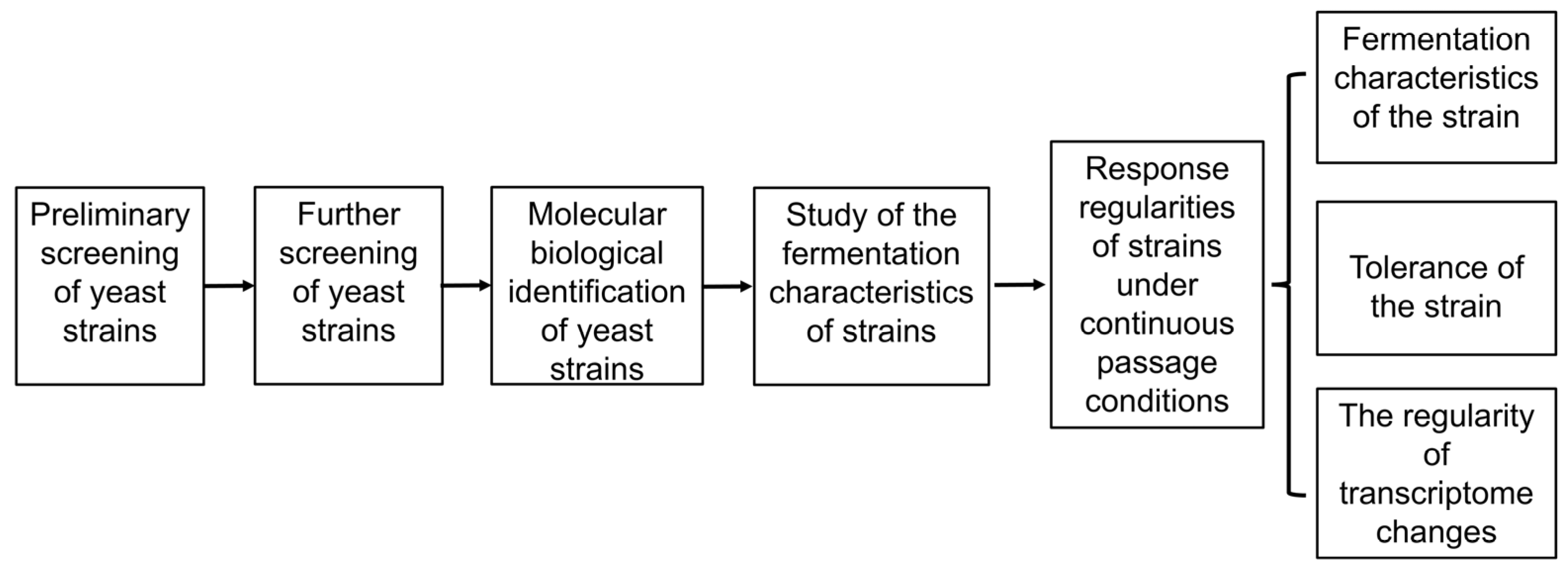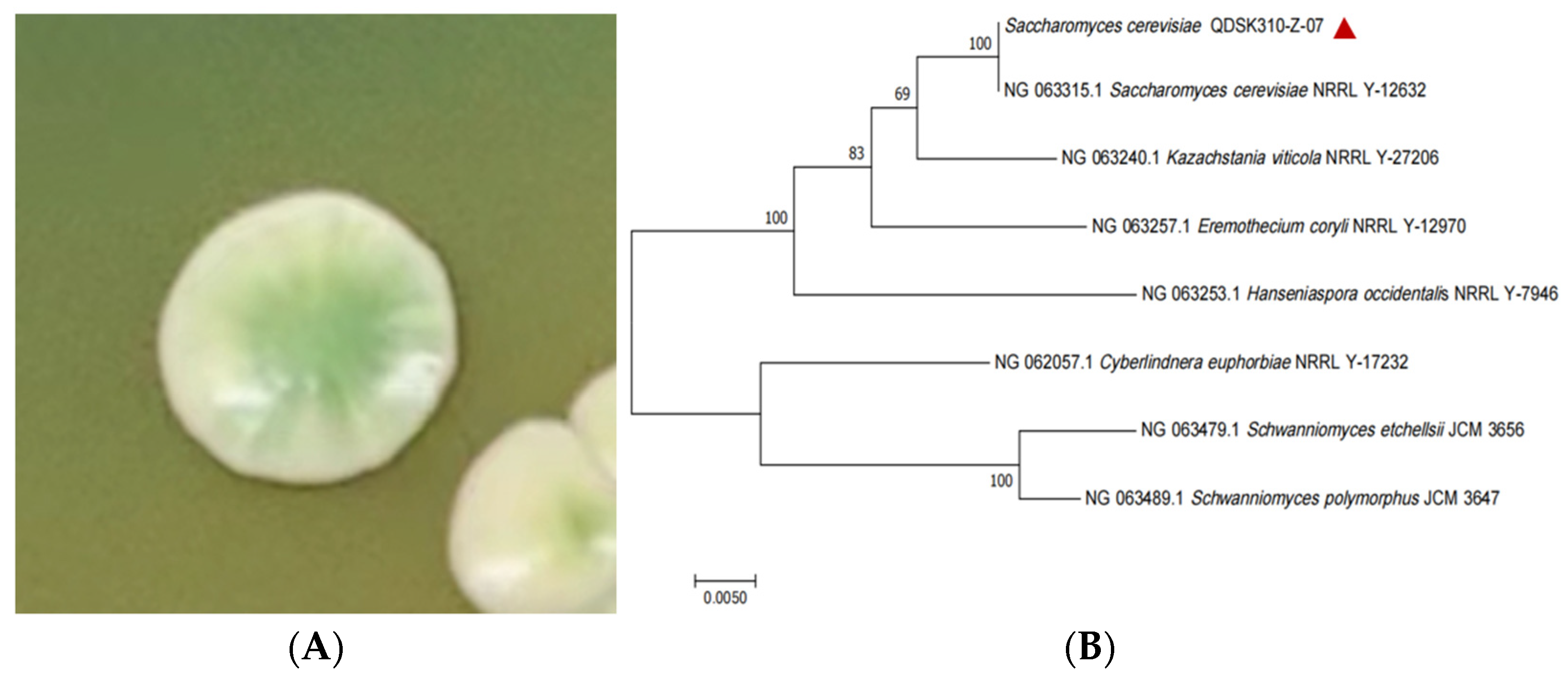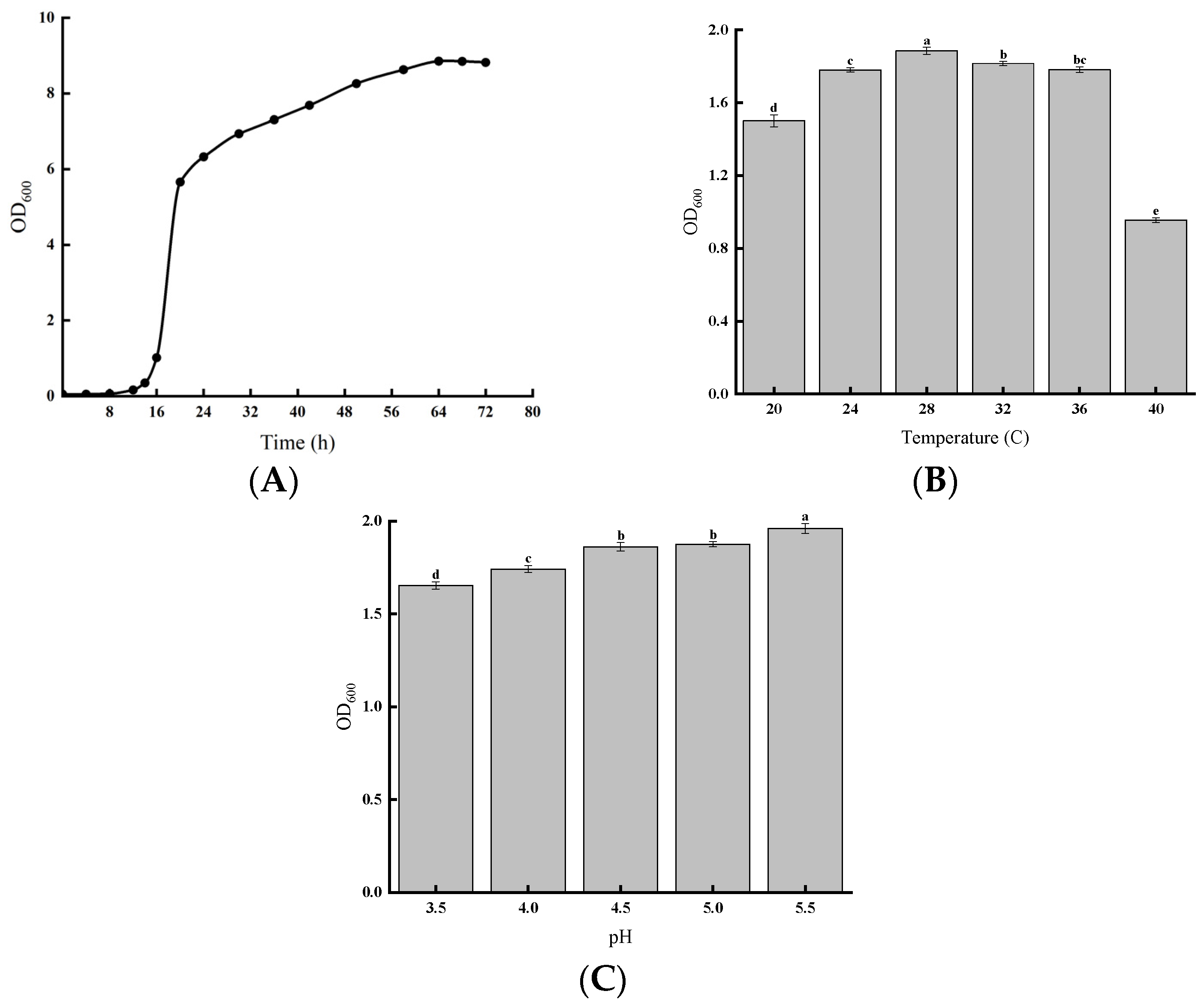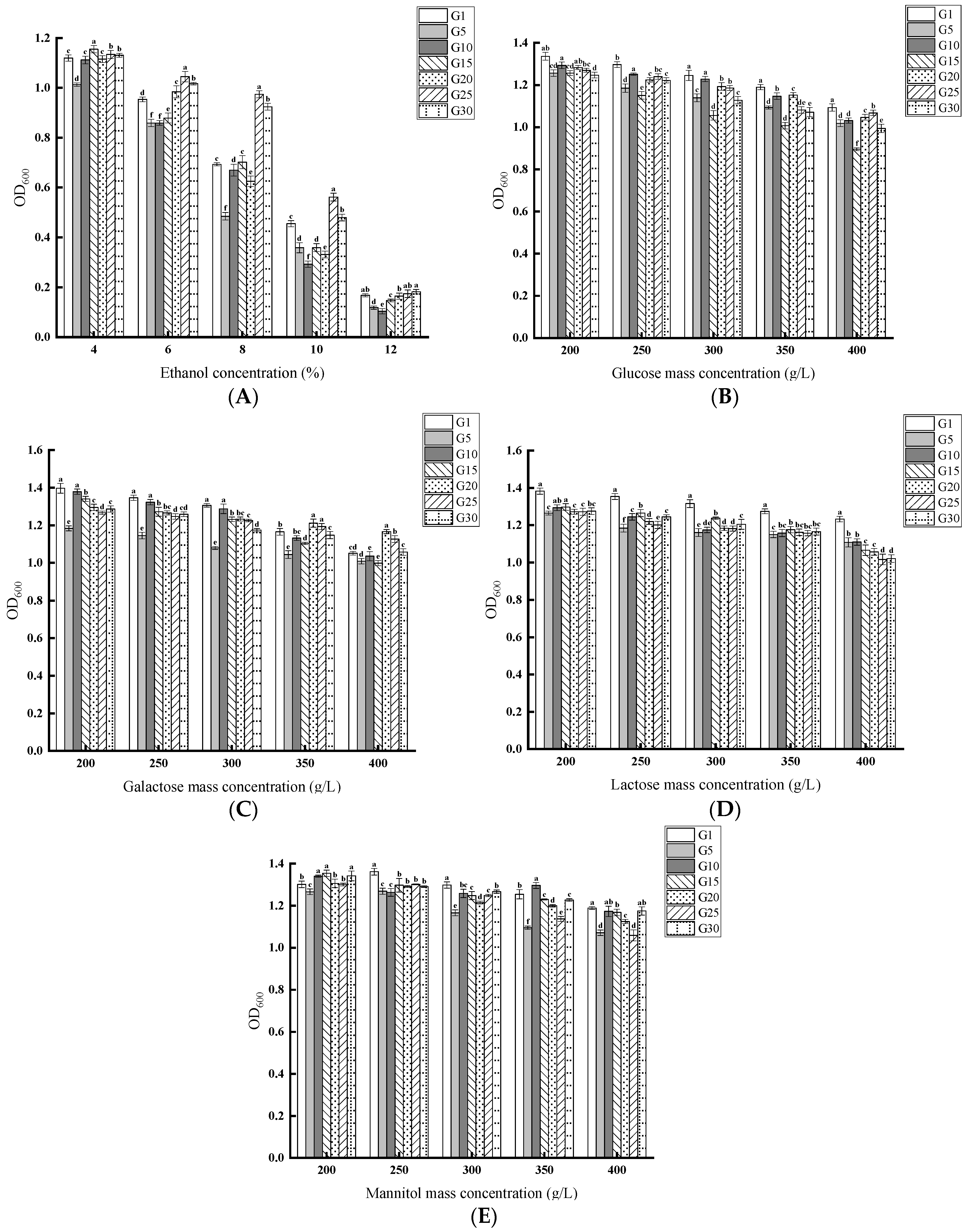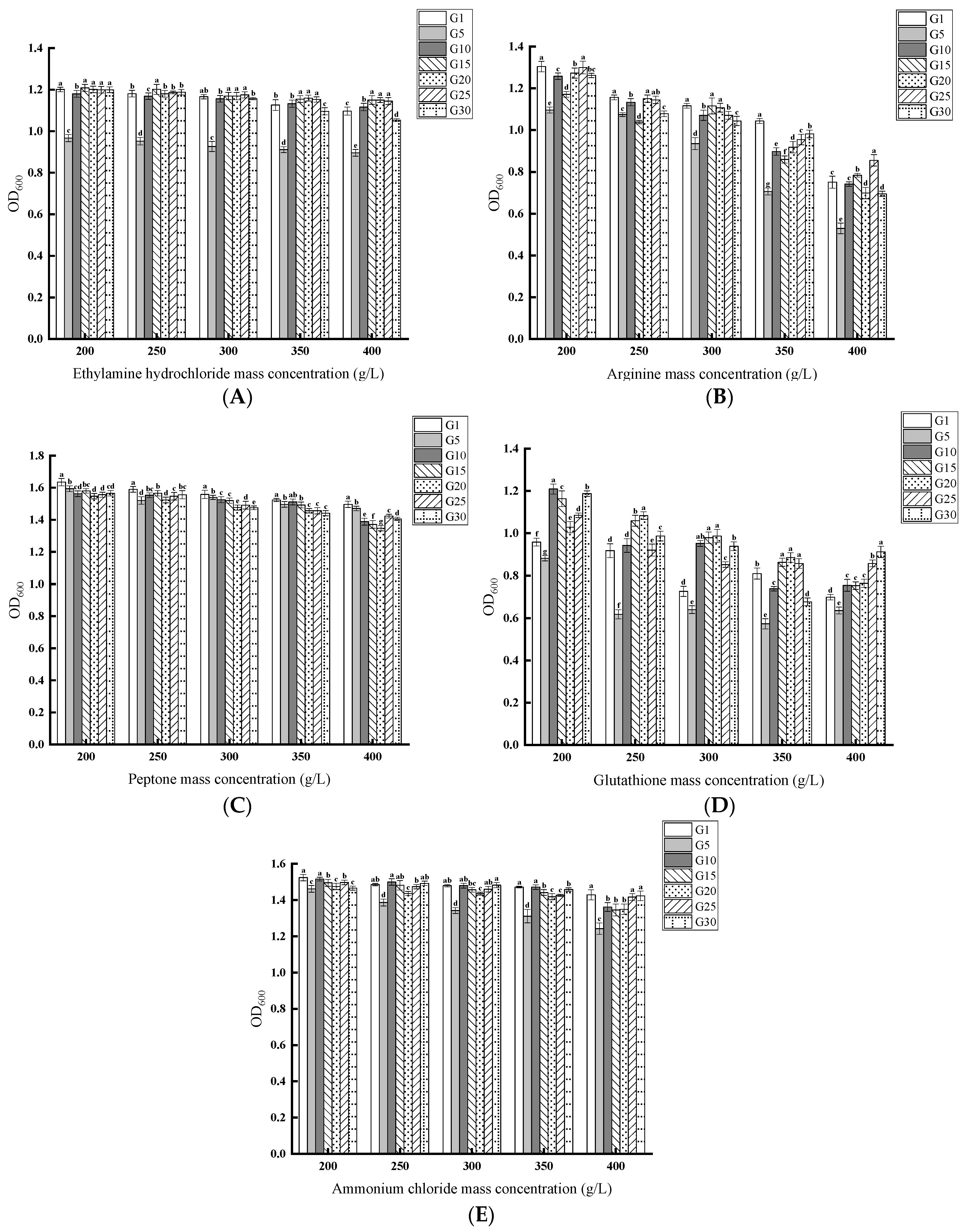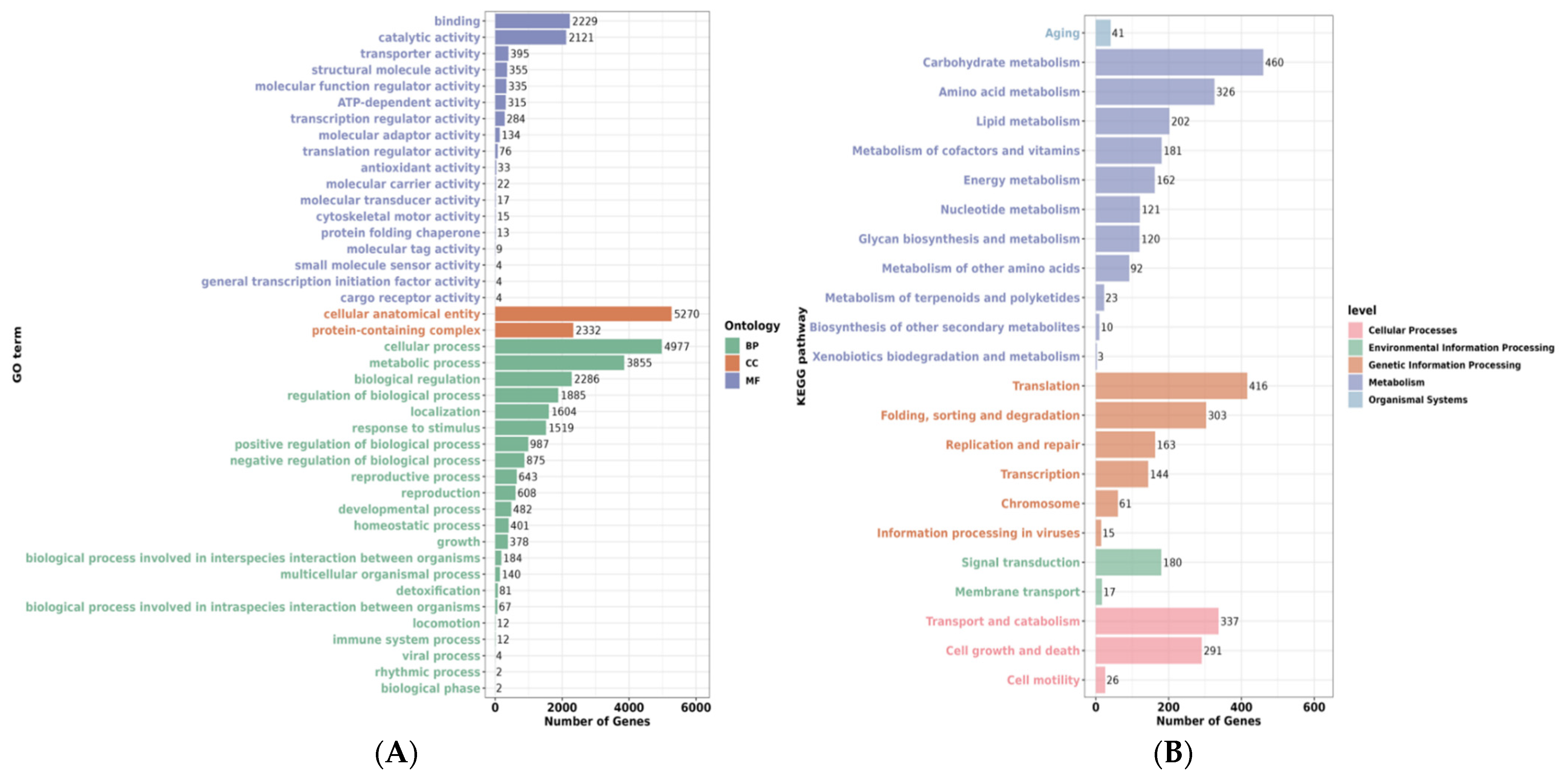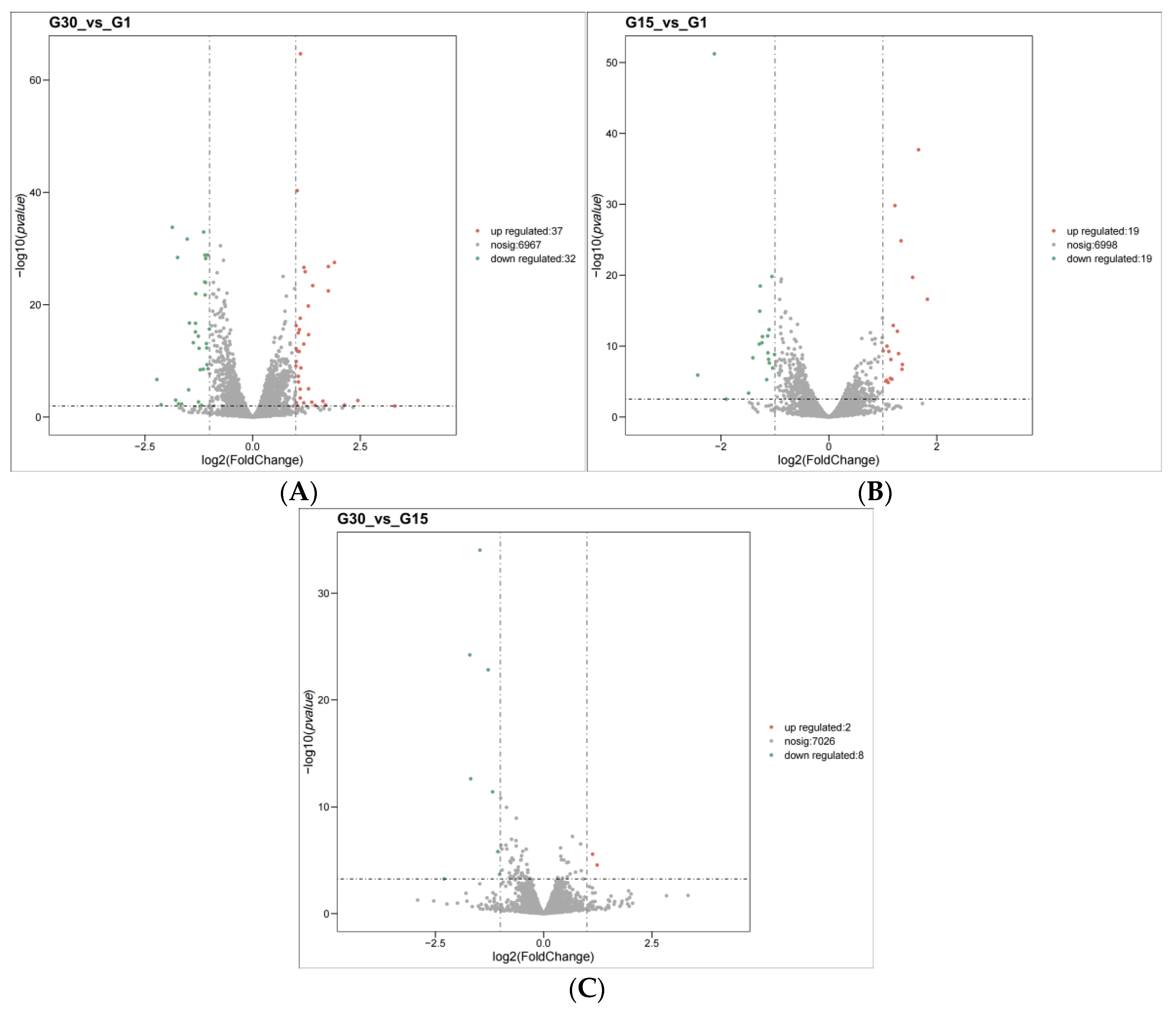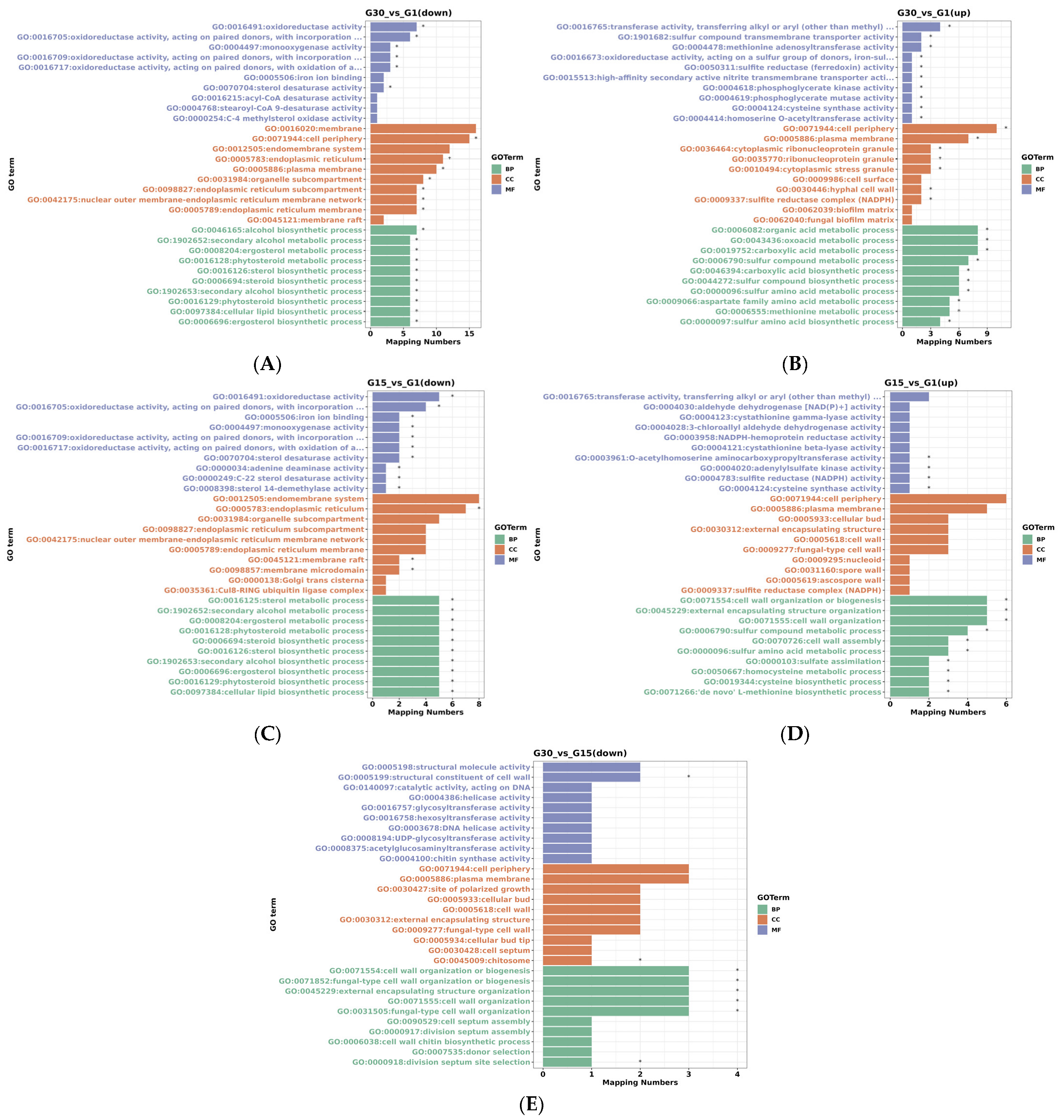1. Introduction
Saccharomyces cerevisiae (
S. cerevisiae), commonly known as brewer’s yeast, is a single-cell fungi. In 1996, Goffeau et al. completed its whole-genome sequencing, making it the first eukaryote to be fully sequenced [
1]. Due to its clear genetic background, convenient molecular manipulation capabilities, and natural resistance to bacteriophage infections [
2,
3],
S. cerevisiae is considered one of the most promising model chassis cells for industrial applications and fundamental research, widely used in various industries such as chemical engineering [
4,
5,
6,
7], food [
8,
9,
10,
11], and medical [
12,
13,
14].
Excellent production strains must exhibit high ethanol yield, rapid fermentation, and robust stress tolerance to maximize efficiency and product quality [
15,
16,
17,
18]. During strain production and application, continuous subculturing is an inevitable process. Studies have demonstrated that serial passaging not only affects the genetic stability of strains but may also exert profound impacts on their metabolic characteristics [
19]. During utilization, strains may exhibit degeneration phenomena, including alterations in original morphology, decreased nutrient utilization capacity, slowed growth rate, and weakened stress resistance [
20,
21,
22]. These changes can subsequently manifest as consistently low yields during production and poor inter-batch reproducibility. Therefore, in-depth investigation of strain genetic stability holds significant theoretical and practical importance for maintaining the superior traits of original strains and ensuring stable, efficient industrial applications [
23].
Current research on genetic stability during subculturing primarily focuses on probiotic strains. For instance, Wang et al. evaluated the genetic stability of
Lactiplantibacillus plantarum P-8 through 100 generations of serial subculturing in MRS medium at 37 °C. Through morphological observation, carbohydrate utilization tests, and whole-genome sequencing analysis, they found no significant changes in cellular morphology or carbohydrate metabolism during passaging. Different generations maintained excellent genome collinearity with high similarity, demonstrating favorable genetic stability of
L. plantarum P-8 during subculturing and establishing a genetic foundation for its industrial application (2023) [
24]. Similarly, Liu et al. comprehensively assessed the genetic stability of
Bifidobacterium animalis subsp.
lactis V9 through phenotypic and genomic analyses. Their results showed no significant differences in cellular morphology or carbohydrate utilization across generations. Phylogenetic tree analysis revealed close genetic relationships between different passages, with no stably inherited mutation sites detected. These findings confirm that V9 maintains stable phenotypic and molecular genetic characteristics through 100 generations of continuous subculturing, providing crucial support for its further development and industrial-scale production (2023) [
25].
However, current research on the genetic stability of yeast during serial subculturing remains relatively limited, highlighting the critical need for further investigation in this field. Strains of brewing yeast were isolated from farm soil, and after continuous subculturing, their biological characteristics were systematically characterized. Additionally, the transgenerational transcriptomic differences under high-sugar stress were elucidated, providing theoretical support for strain development and application. Compared to existing studies focusing on environmental stress responses in wild-type strains, these findings hold significant value for constructing microbial resource banks and exploring industrial potential.
2. Materials and Methods
2.1. Materials
The soil samples were collected from farm soils in Rizhao City, Shandong Province, China. YPD liquid medium, yeast agar, and WL medium were bought from Qingdao Hope Bio-Technology Co., Ltd., Qingdao, China. TTC medium was composed of upper and lower media layers. TTC upper medium comprised 5 g/L glucose (Sinopharm Chemical Reagent Co., Ltd., Shanghai, China), 0.5 g/L TTC (Shanghai Macleane Biochemical Technology Co., Ltd., Shanghai, China), and 15 g/L agar powder (Biosharp Biotechnology Co., Ltd., Anhui, China). TTC lower medium was composed of 10 g/L glucose, 1.5 g/L yeast extract (Sinopharm Chemical Reagent Co., Ltd., Shanghai, China), 2 g/L peptone (Beijing Oboxing Biotechnology Co., Ltd., Beijing, China), 0.4 g/L magnesium sulfate (Tianjin Beilian Fine Chemicals Development Co., Ltd., Tianjin, China), 1.0 g/L potassium dihydrogen phosphate (Sinopharm Chemical Reagent Co., Ltd.), and 20 g/L agar powder (pH 5.4–5.6). Anhydrous ethanol, galactose, lactose, soluble starch, citric acid, ethylamine hydrochloride, arginine, and ammonium chloride were all purchased from Sinopharm Chemical Reagent Co., Ltd. Glutathione was purchased from Shanghai Macleane Biochemical Technology Co., Ltd. Mannitol was purchased from Shanghai Aladdin Biochemical Technology Co., Ltd., Shanghai, China.
2.2. Methods
The experimental flow of this research is shown in
Figure 1.
2.2.1. Selection and Identification of Strains
(1) Preliminary screening of yeast strains
The initial bacterial suspension was serially diluted with sterile water at a 10-fold gradient. The diluted samples were spread onto yeast agar and incubated in a 28 °C electrically heated incubator (DHP-9052, Qingdao Lantenn Science and Education Instrument and Equipment Co., Ltd., Qingdao, China) for 24–48 h. Isolation and purification were carried out following established protocols, and the resulting strains were numbered and preserved [
26,
27,
28].
2,3,5-triphenyltetrazolium chloride (TTC) chromogenic experiments: Isolated yeast strains were streaked onto the lower layer of TTC medium and incubated at 28 °C for 3 days. After colony formation, the upper TTC medium was poured over the colonies and incubated at 28 °C in the dark for 3 h [
29]. Strains with darker colony colors were selected for the gas production fermentation experiment [
28].
Experiments on gas production by Durham tubule fermentation: By monitoring the gas-filling state of the Durham tube and the time required for complete gas accumulation, the fermentation rate and gas-producing capability of the strain can be evaluated [
28,
30]. An amount of 10 mL YPD liquid medium was aliquoted into 15 mL test tubes, inverted, and placed in Durham tubes. After sterilization (vertical autoclave, YXQ-LS-50SI, Shanghai Boxun Industrial Co., Ltd. Medical Equipment Factory, Shanghai, China), and cooling, a 5% inoculum was added, and the tubes were incubated at 28 °C. The gas volume and time required to fill the Durham tubes were recorded every 6 h [
30]. Based on the preliminary screening results, strains with strong alcohol production, rapid fermentation, and high gas production were selected for further screening.
(2) Further screening of yeast strains
The selected strains were streaked onto WL medium and incubated at 28 °C for 3–5 days. After colony formation, the strains were preliminarily identified based on the colony morphology observed on the WL medium [
31].
(3) Molecular biological identification of yeast strains
Single colonies isolated from culture media were subjected to DNA extraction. After successful extraction, PCR amplification and agarose gel electrophoresis were performed, and the product was sequenced. The sequencing results were compared with homologous sequences using the Basic Local Alignment Search Tool (BLAST) from the National Center for Biotechnology Information (NCBI). Finally, the phylogenetic tree of the strains was constructed using MEGA7.0.26.
2.2.2. Study of the Fermentation Characteristics of Strains
Yeast strains were cultured in YPD liquid medium (28 °C, 150 rpm) to measure OD
600 values (ultraviolet spectrophotometer, UV-8000, Shanghai Yuanxi Instrument Co., Ltd., Shanghai, China) and generate growth curves. The ability of yeast strains to utilize various carbon sources (glucose, galactose, lactose, soluble starch, citric acid, and mannitol) and nitrogen sources (ethylamine hydrochloride, arginine, peptone, glutathione, and ammonium chloride) was evaluated by Durham tubes fermentation test. Strain adaptability was assessed across temperature gradients (20–40 °C) and pH ranges (3.5–5.5) [
32,
33].
2.2.3. Response Regularities of Strains Under Continuous Passage Conditions
The selected and identified strains were continuously passed up to 30 generations, designated G1, G2, and G30, respectively. The biological characteristics of G1, G5, G10, G15, G20, G25, and G30 were compared.
(1) Fermentation characteristics of the strain.
Durham tubule fermentation gas production experiment and TTC chromogenic experiment were used to explore the changes in fermentation ability of strains after passage.
(2) Tolerance of the strain.
Anhydrous ethanol was added to the YPD liquid medium at different concentrations (4%, 6%, 8%, 10%, and 12%). The medium was inoculated with 1% inoculum and incubated at 28 °C for 48 h, and the OD
600 of the fermentation liquid was measured [
17,
34,
35].
Based on the yeast strain’s utilization of different carbon and nitrogen sources, solutions of the most efficiently utilized carbon and nitrogen sources were prepared at 200 g/L, 250 g/L, 300 g/L, 350 g/L, and 400 g/L [
36]. The experimental parameters were the same as those in the carbon and nitrogen source assimilation capacity study, and the OD
600 of the fermentation liquid was measured.
(3) The regularity of transcriptome changes.
In view of the differences in the growth conditions of different generations of
S. cerevisiae QDSK310-Z-07 at a glucose concentration of 400 g/L, transcriptome analysis of G1, G15, and G30 was carried out in this research. After obtaining all raw sequences from the second-generation, high-throughput sequencing platform, the sequences were processed to remove low-quality reads and adapter contamination, resulting in high-quality sequences. After the transcriptome data quality assessment was qualified, comprehensive analysis was performed using Gene Ontology (GO) and the Kyoto Encyclopedia of Genes and Genomes (KEGG) databases [
37,
38,
39].
2.3. Data Analysis
All experiments were performed in triplicate replicates, the experimental data were analyzed and processed by SPSS 27.0 software, the one-way ANOVA was analyzed using Duncan’s test, and Origin2021 and MEGA 7.0.26 software generated the graphs.
4. Discussion
Industrial
S. cerevisiae used in production has many excellent characteristics, such as high ethanol production capacity, strong tolerance, and genetic stability [
33,
40,
41,
42,
43]. Therefore, studying the characteristics of independently selected strains is particularly important. Carbon and nitrogen sources are essential substances for microbial life activities, and different carbon and nitrogen sources have varying effects on yeast. The ability of yeast to utilize different carbon and nitrogen sources also varies. Experiments showed that
S. cerevisiae QDSK310-Z-07 has strong glucose, galactose, and peptone assimilation ability. In contrast, its ability to assimilate mannitol, ethylamine hydrochloride, glutathione, and ammonium chloride is moderate, and it has poor assimilation ability for soluble starch and citric acid. Aké et al. systematically investigated the assimilation and fermentation capabilities of multiple yeast strains toward six carbon sources: glucose, galactose, fructose, lactose, sucrose, and maltose. Unlike our study, all strains in the Aké et al. research could assimilate sucrose and glucose but could not assimilate lactose. Some strains, like
Pichia kudriavzevii AR 2-32-2 and
Pichia manshuurica RE 2-2, could not assimilate galactose (2019) [
44]. Yeast prioritizes easily decomposed substances with lower ATP consumption when various carbon sources are present, supporting our findings from carbon source assimilation experiments [
33,
41].
Temperature affects the survival rate and fermentation rate of yeast, and the yeast strains used in fermentation should exhibit good thermal stability [
45]. Our experimental results demonstrated that the
S. cerevisiae QDSK310-Z-07 exhibited robust growth within the temperature range of 24–36 °C, with 28 °C identified as its optimal growth temperature. This thermal adaptation characteristic aligns with the findings of Zhang et al., whose studied yeast strain Y2 similarly showed optimal growth at 28 °C (2020) [
28]. Notably, low pH conditions during fermentation were observed to significantly inhibit yeast growth and metabolic activity, ultimately leading to complete fermentation arrest. These findings underscore the importance of investigating pH adaptation characteristics for industrial applications of this strain. When the pH range was 3.5–5.5, and the yeast strain was cultured at 28 °C for 24 h, growth was gradually inhibited as the pH decreased. The trend of growth inhibition at different pH conditions was consistent with the results of Olee et al. (2022) [
46]. In the laboratory, the TTC colorimetric method is commonly employed to assess the alcohol-producing capacity of yeast strains. The principle of this method lies in the reaction between the metabolic byproducts of yeast strains and the chromogenic agent TTC. A more intense coloration indicates higher respiratory enzyme activity in the yeast strain, which corresponds to greater alcohol production capability [
29]. The colorimetric analysis on TTC medium revealed distinct ethanol production capacities among different generations of yeast strains. Strain G1 and G5 maintained high-yield ethanol production levels after continuous subculturing. Following G10, strain G15 exhibited a modest enhancement in ethanol production capacity, which subsequently stabilized at medium-yield levels. These findings demonstrate relatively stable ethanol-producing performance throughout the serial passaging process. Gas production experiments showed that fermentation capacity slightly increased in G10 and G15 after G5, but fermentation capacity gradually decreased with continuous subculturing. The specific reasons for this decline need further investigation at the metabolomic and transcriptomic levels.
Ethanol is a fermentation product of
S. cerevisiae, but high ethanol concentrations can lead to protein denaturation, decreased cell viability, increased mortality, and subsequently affect the fermentation process [
47,
48]. The high ethanol tolerance of
S. cerevisiae facilitates complete fermentation during the brewing process and increases the alcohol content of the product. We found that growth across different yeast generations gradually decreased as ethanol concentration increased.
S. cerevisiae QDSK310-Z-07 showed strong growth in environments with ethanol concentrations of 4–8%, but growth significantly slowed at concentrations exceeding 10%. Therefore, the yeast strain exhibited ethanol tolerance up to 8%. This growth trend was consistent with the results of Long et al., and the ethanol tolerance of the strains screened in this research was better than that of the yeast strains screened by Long et al. (6% ethanol tolerance) (2024) [
31]. Additionally, G5 and G10 showed more potent growth inhibition under the same ethanol concentration than other generations.
Current research on carbon and nitrogen sources for S. cerevisiae mainly focuses on utilizing different carbon and nitrogen sources, with limited exploration of yeast growth after continuous subculturing under varying concentrations of carbon and nitrogen sources. This research examined the growth of different yeast generations under different concentrations of carbon and nitrogen sources based on their utilization of these sources. Increased concentrations of carbon and nitrogen sources affected yeast growth to varying degrees, and the inhibitory effect on different yeast generations varied under the same carbon and nitrogen source concentration. For instance, generation G5 exhibited more significant inhibition under the same arginine concentration compared to other generations.
During fermentation, high glucose concentrations create a hyperosmotic environment, leading to yeast cell rupture, water loss, and reduced activity, inhibiting yeast growth, potentially altering metabolism, or making fermentation difficult [
49,
50,
51]. As glucose concentration increased, the growth of different generations of
S. cerevisiae QDSK310-Z-07 was increasingly inhibited. This trend is consistent with the findings of Long et al., where yeast strain LJM-4 growth was gradually inhibited as glucose concentration increased from 200 g/L to 350 g/L and then to 400 g/L (2024) [
31]. However, under the same glucose concentration, the reasons for the different degrees of inhibition of different generations of strains need to be further explored.
Transcriptomics was used to study the gene expression differences of different generations of
S. cerevisiae at a glucose concentration of 400 g/L. The proportion of genes in different functional categories reflects the metabolic or physiological biases under specific periods and conditions. The transcriptome results of G1, G15, and G30 showed that the expression of genes related to amino acid metabolism, amino sugar and nucleotide sugar metabolism, and lipid metabolism was significantly different in the continuous passage of
S. cerevisiae QDSK310-Z-07 in a high glucose environment. Consistent with existing theories, our experimental results confirm that yeast cells counteract high-sugar stress through coordinated mechanisms, such as ergosterol metabolism, membrane permeability regulation, and signal transduction activation [
38,
52,
53]. It was inferred that when the glucose concentration was 400 g/L, compared with G1 and G30, the growth of G15 was strongly inhibited, which was significantly related to the significant expression of differential genes. To further investigate the molecular mechanisms underlying this high-glucose tolerance, key DEGs (
Table A1) identified from major metabolic pathways should be validated via quantitative real-time PCR (qPCR). This follow-up experiment would elucidate the relationship between the expression levels of these critical genes and the strain’s osmotolerant phenotype, providing deeper insights into its adaptive responses.
Based on the experimental results obtained in this research, future research could explore the following directions in greater depth:
(1) Regarding the environmental stress tolerance exhibited by S. cerevisiae QDSK310-Z-07, genetic engineering approaches could be employed to enhance the expression of stress-resistant genes. For instance, gene editing technologies could be utilized to precisely regulate the expression levels of stress-related genes, while adaptive laboratory evolution strategies could be integrated to develop superior strains with multi-stress tolerance. This would enable the strain to thrive in the complex conditions of industrial production, ultimately cultivating strains with higher industrial applicability.
(2) This study primarily examined the biological characteristics of S. cerevisiae QDSK310-Z-07 at G1, G5, G10, G15, G20, G25, and G30 generations. Building upon these findings, more detailed and in-depth investigations could be conducted to comprehensively assess the strain’s genetic stability and fermentation performance over prolonged serial passages. Such research would help evaluate its potential as a standard reference strain and lay a theoretical foundation for establishing a strain seed bank.
5. Conclusions
We isolated S. cerevisiae strains from farm soil and investigated their biological characteristics at both macroscopic and microscopic levels. The main findings are as follows:
(1) The farm soils were used as the isolation source, and the strain of S. cerevisiae QDSK310-Z-07 was independently screened. The strain exhibits broad adaptive growth characteristics: it grows well within a temperature range of 24–36 °C, with an optimal growth temperature of 28 °C. It maintains stable growth at pH 4.0–5.5 and demonstrates efficient utilization of various carbon and nitrogen sources. These findings offer novel microbial resources with potential industrial applications.
(2) The study investigated the changes in alcohol production capacity, fermentation rate, and tolerance to products and various substrates of the strain after subculturing. After continuous subculturing, the strain’s ethanol tolerance and fermentation capacity decreased, with ethanol production capacity gradually stabilizing at a medium level. With increase in concentration, the tolerance to various carbon and nitrogen sources and ethanol decreased to varying degrees. The results delineate the strain’s adaptive response patterns following serial passaging, offering novel research avenues for investigating genetic stability while establishing a robust foundation for developing strain seed banks and advancing yeast strain applications.
(3) Transcriptomics analysis revealed differences in gene expression related to lipid metabolism and amino acid metabolism in yeast strains sub-cultured under high-sugar environments. These findings provide a crucial theoretical foundation for the industrial application of this strain, while also offering clear guidance for subsequent strain improvement and fermentation process optimization.
